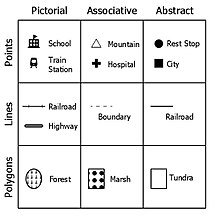Symbol


A symbol is a mark,
The academic study of symbols is semiotics. In cartography, an organized collection of symbols forms a legend for a map.
Etymology
The word symbol derives from the late Middle French masculine noun symbole, which appeared around 1380 in a theological sense signifying a formula used in the Roman Catholic Church as a sort of synonym for 'the credo'; by extension in the early Renaissance it came to mean 'a maxim' or 'the external sign of a sacrament'; these meanings were lost in secular contexts. It was during the Renaissance in the mid-16th century that the word took on the meaning that is dominant today, that of 'a natural fact or object evoking by its form or its nature an association of ideas with something abstract or absent'; this appears, for example, in
Concepts and definitions
Symbols are a means of complex communication that often can have multiple levels of meaning.[5] Symbols are the basis of all human understanding and serve as vehicles of conception for all human knowledge.[6] Symbols facilitate understanding of the world in which we live, thus serving as the grounds upon which we make judgments.[7] In this way, people use symbols not only to make sense of the world around them, but also to identify and cooperate in society through constitutive rhetoric.
Human cultures use symbols to express specific ideologies and social structures and to represent aspects of their specific culture. Thus, symbols carry meanings that depend upon one's cultural background. As a result, the meaning of a symbol is not inherent in the symbol itself but is culturally learned.[5]
Heinrich Zimmer gives a concise overview of the nature, and perennial relevance, of symbols.
Concepts and words are symbols, just as visions, rituals, and images are; so too are the manners and customs of daily life. Through all of these a transcendent reality is mirrored. There are so many metaphors reflecting and implying something which, though thus variously expressed, is ineffable, though thus rendered multiform, remains inscrutable. Symbols hold the mind to truth but are not themselves the truth, hence it is delusory to borrow them. Each civilisation, every age, must bring forth its own."[8]
In the book Signs and Symbols, it is stated that
A symbol ... is a visual image or sign representing an idea – a deeper indicator of universal truth.[9]
Symbols and semiotics
Semiotics is the study of signs, symbols, and signification as communicative behavior. Semiotics studies focus on the relationship of the signifier and the signified, also taking into account the interpretation of visual cues, body language, sound, and other contextual clues. Semiotics is linked with linguistics and psychology. Semioticians not only study what a symbol implies but also how it got its meaning and how it functions to make meaning in society. For example, symbols can cause confusion in translation when the same symbol mean different things in the source and target languages. A potential error documented in survey translation is the symbol of "x" used to denote "yes" when marking a response in the English language surveys, but "x" usually means "no" in the Chinese convention.[10] Symbols allow the human brain continuously to create meaning using sensory input and decode symbols through both denotation and connotation.
Psychoanalysis, rhetoric, and archetypes
An alternative definition of symbol, distinguishing it from the term
Burke goes on to describe symbols as also being derived from Sigmund Freud's work on condensation and displacement, further stating that symbols are not just relevant to the theory of dreams but also to "normal symbol systems". He says they are related through "substitution", where one word, phrase, or symbol is substituted for another in order to change the meaning.[clarification needed] In other words, if one person does not understand a certain word or phrase, another person may substitute a synonym or symbol in order to get the meaning across. However, upon learning the new way of interpreting a specific symbol, the person may change his or her already-formed ideas to incorporate the new information.
Jean Dalby Clift says that people not only add their own interpretations to symbols, they also create personal symbols that represent their own understanding of their lives: what she calls "core images" of the person. Clift argues that symbolic work with these personal symbols or core images can be as useful as working with dream symbols in psychoanalysis or counseling.[12]
William Indick suggests that the symbols that are commonly found in myth, legend, and fantasy fulfill psychological functions and hence are why archetypes such as "the hero", "the princess" and "the witch" have remained popular for centuries.[13]
Symbolic value
Symbols can carry symbolic value in three primary forms: Ideological, comparative, and isomorphic.[14] Ideological symbols such as religious and state symbols convey complex sets of beliefs and ideas that indicate "the right thing to do". Comparative symbols such as prestigious office addresses, fine art, and prominent awards indicate answers to questions of "better or worse" and "superior or inferior". Isomorphic symbols blend in with the surrounding cultural environment such that they enable individuals and organizations to conform to their surroundings and evade social and political scrutiny. Examples of symbols with isomorphic value include wearing a professional dress during business meetings, shaking hands to greet others in the West, or bowing to greet others in the East. A single symbol can carry multiple distinct meanings such that it provides multiple types of symbolic value.[14]
Paul Tillich
Paul Tillich argued that, while signs are invented and forgotten, symbols are born and die.[15] There are, therefore, dead and living symbols. A living symbol can reveal to an individual hidden levels of meaning and transcendent or religious realities. For Tillich a symbol always "points beyond itself" to something that is unquantifiable and mysterious; symbols open up the "depth dimension of reality itself".[16] Symbols are complex, and their meanings can evolve as the individual or culture evolves. When a symbol loses its meaning and power for an individual or culture, it becomes a dead symbol. When a symbol becomes identified with the deeper reality to which it refers, it becomes idolatrous as the "symbol is taken for reality." The symbol itself is substituted for the deeper meaning it intends to convey. The unique nature of a symbol is that it gives access to deeper layers of reality which are otherwise inaccessible.[17]
Role of context in symbolism
This section possibly contains original research. (January 2010) |
A symbol's
Historical meaning
The history of a symbol is one of many factors in determining a particular symbol's apparent meaning. Consequently, symbols with emotive power carry problems analogous to
Context
The context of a symbol may change its meaning. Similar five-pointed stars might signify a
Symbols in cartography

Symbols are used in cartography to communicate geographical information (generally as point, line, or area features).[19] As with other symbols, visual variables such as size, shape, orientation, texture, and pattern provide meaning to the symbol.[20] According to semiotics, map symbols are "read" by map users when they make a connection between the graphic mark on the map (the sign), a general concept (the interpretant), and a particular feature of the real world (the referent). Map symbols can thus be categorized by how they suggest this connection:[21][22]
- Pictorial symbols (also "image", "iconic", or "replicative") appear as the real-world feature, although it is often in a generalized manner; e.g. a tree icon to represent a forest, or green denoting vegetation.
- Functional symbols (also "representational") directly represent the activity that takes place at the represented feature; e.g. a picture of a skier to represent a ski resort or a tent to represent a campground.
- Conceptual symbols directly represent a concept related to the represented feature; e.g. a dollar sign to represent an ATM, or a Star of David to represent a Jewish synagogue.
- Conventional symbols (also "associative") do not have any intuitive relationship but are so commonly used that map readers eventually learn to recognize them; e.g. a red line to represent a highway or a cross to represent a hospital.
- Abstract/geometric symbols (also "ad hoc") are arbitrary shapes chosen by the cartographer to represent a certain feature.
Related terms
A symbolic action is an action that symbolizes or signals what the actor wants or believes. The action conveys meaning to the viewers. Symbolic action may overlap with
See also
- Alchemical symbol
- Astrological symbols
- Astronomical symbols
- Emblem
- secular icon
- List of symbols
- Logo
- National symbol
- National treasure
- Pictogram
- Proto-writing
- Sign
- Symbolic interactionism
- Symbolism (arts)
- Table of mathematical symbols
- Traffic signs
- Unicode symbols
- Universal language
References
- ^ Alain Rey et al., eds., Dictionnaire historique de la langue française, new edition, vol. 2 (Paris: Dictionnaires Le Robert, 1995), p. 2082.
- ^ Eric Partridge, Origins: A Short Etymological Dictionary of Modern English, 2nd ed. (New York: Macmillan, 1959), p. 688.
- ^ Alain Rey et al., eds., Dictionnaire historique de la langue française, new edition, vol. 2 (Paris: Dictionnaires Le Robert, 1995), p. 2082.
- ^ "symbol | Search". Online Etymology Dictionary. Archived from the original on Jul 2, 2017.
- ^ a b Womack, Mari. Symbols and Meaning: A Concise Introduction. California: AltaMira Press, 2005.
- ^ Langer, Susanne K. A Theory of Art, Developed From: Philosophy in a New Key. New York: Charles Scribner's Sons, 1953.
- ^ Palczewski, Catherine, and Ice, Richard, and Fritch, John. Rhetoric in Civic Life. Pennsylvania: Strata Publishing, Inc., 2012.
- ISBN 0-691-01758-1.
- ISBN 978-0-7566-3393-6. 2008
- S2CID 198632812.
- ^ Christ, A symbol of the self CW vol 9i Aion RKP 1958
- ^ Jean Dalby Clift, Core Images of the Self: A Symbolic Approach to Healing and Wholeness. Crossroad, 1992. [page needed]
- ^ Indick, William. Ancient Symbology in Fantasy Literature: A Psychological Study. Jefferson: McFarland &, 2012. Print.
- ^ S2CID 150656804.
- ISBN 0195007115.
- ISBN 0195007115.
- ISBN 0195007115.
- ^
Compare:
Basso, Michele (1982). Eschatological symbolism in the Vatican Necropolis. Tipografia Poliglotta Vaticana. p. 700. Retrieved 2019-01-05.
In a late period the Greeks made [Pan] the incarnation of All (giving a false etymology to his name, which is really connected with the pastures), that is to say, the universe.
- OCLC 437300476.
- OCLC 184827987.
- ^ MacEachren, Alan (1995) How Maps Work: Representation, visualization, and design, New York: Guilford Press
- ISBN 0697384950.
- ISBN 9783640129546. p. 16–17.
- ISBN 9780549738817. p. 17.

